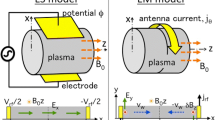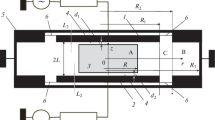Abstract
Reducing the ICRH (ion cyclotron range frequency) antenna-plasma interaction is one of the key points for reaching very long tokamak discharges. One problem which limits such discharges, is the appearance of hot spots on the surface of the antenna: Radio Frequency (RF) sheaths modify the properties of the edge plasma by rectifying the RF potential along open magnetic field lines and can induce hot spots. This paper investigates the corrections to sheath potentials introduced by the interactions between adjacent flux tubes. Our theoretical study started from an oscillating double Langmuir probe model, in which a transverse influx of current was included. This model was confronted with 1D PIC simulations along a magnetic field line, and demonstrated that current exchanges can decrease mean potentials. A 2D electrostatic fluid code was then developed, which couples adjacent flux tubes in a poloidal cross section with collisional conductivity or polarization currents. It showed that transverse currents are able to smooth structures smaller than a characteristic size in the sheath potential maps (results for Tore Supra). These computed rectified potentials can be used to obtain the DC electric fields in front of the antenna. And then, it gives an estimate of the particle drift and the energy flux on the antenna structure, which can explain hot spots.
Similar content being viewed by others
References
J-M. Noterdaeme and G. Van Oost: Plasma Phys. Control. Fusion 35 (1993) 1481.
L. Colas et al.: Nucl. Fusion 43 (2003) 1.
D.A. D'Ippolito and al.: Phys. Fluids B 5 (1993) 3603.
M. Becoulet et al.: Plasma Phys. 9 (2002) 2619.
A.V. Nedospasov and D.A. Uzdensky: Contrib. Plasma Phys. 34 (1994) 478.
D.A. D'Ippolito and J.R. Myra: Phys. Plasmas 7 (2000) 3301.
V. Rozhansky et al.: Contrib. Plasma Phys. 36 (1996) 391.
K. Gunther and A. Carlson: Contrib. Plasma Phys. 34 (1994) 484.
J.P. Verboncoeur et al.: J. Comput. Phys. 104 (1993) 321.
Vahid Vahedi and John P. Verboncoeur c/o Prof. C.K. Birdsall Plasma Theory and Simulation Group, Berkeley, XPDP1 reference manual.
A. Carlson: Phys. Plasmas 8 (2001) 4732. Czech. J. Phys. 53 (2003) 923
Author information
Authors and Affiliations
Rights and permissions
About this article
Cite this article
Faudot, E., Heuraux, S. & Colas, L. Modelling of DC Electric Fields Induced by RF Sheath in Front of ICRF Antenna. Czechoslovak Journal of Physics 53, 911–923 (2003). https://doi.org/10.1023/A:1026396507625
Issue Date:
DOI: https://doi.org/10.1023/A:1026396507625




